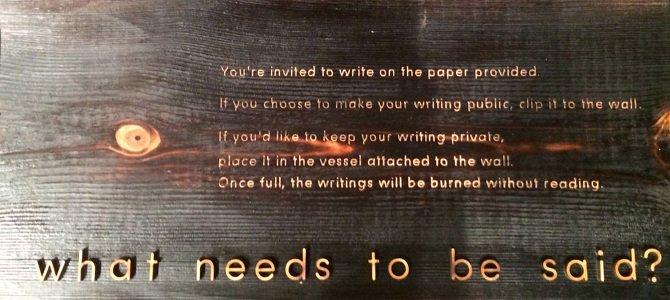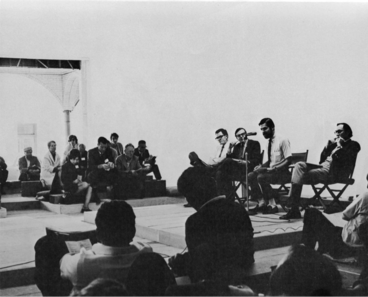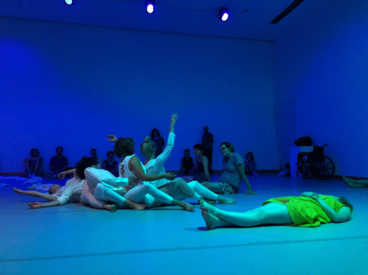The Target Studio for Creative Collaboration’s current exhibition The Talking Cure features an interactive art piece by artist-in-residence Rebecca Krinke titled What Needs to be Said? The work was inspired by Japanese tokonoma. The tokonoma is a raised alcove space often found in traditional Japanese architecture and used to comment, question, or illuminate aspects of existence. Krinke’s tokonoma of sorts poses the question “What needs to be said?” asking viewers to respond on provided sheets of paper and to choose to either pin their response to the sculpture, allowing for it to be read, or to deposit it in a frosted glass vessel where it will eventually be burned. The piece provides a platform for the visitors to explore, what curator Laura Joseph calls, “the cathartic possibilities of speaking up.” According to the artist, the work emerged in response to a “tremendous need for new places and objects to address our emotional lives.”
Opening late last summer, the installation of this exhibition coincided with my first experience saying what I needed to say at a Break the Silence event, an entirely separate project and venue with a similar goal of allowing members of the community to acknowledge and speak their emotional truths. Break the Silence is a local organization founded by a radically wonderful activist, trauma yoga instructor, and compassionate human named Sarah Super. The organization’s mission is to end rape culture, hold perpetrators accountable, and support survivors of sexual violence in healing. They work towards these goals through a series of truth telling events and community resources that empower survivors of sexual violence to come forward and tell their stories.
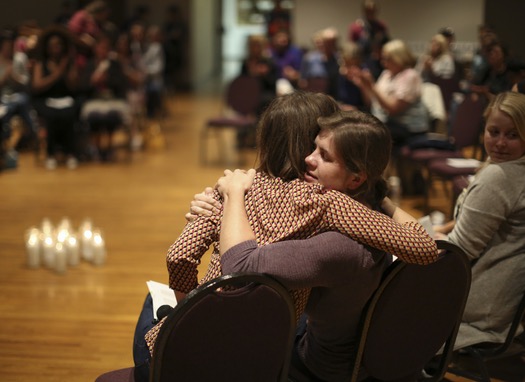
This spring our current Minnesota Student Association President, Abeer Syedah asked me if the WAM Collective would collaborate with other student groups in raising money to bring our own campus resource for survivors of sexual violence, the Aurora Center, out of deficit. After immediately saying “of course!” (and then confirming with our other members) I thought of What Needs to be Said and the question’s applicability to the experience of sexual assault survivors, who are so often denied a voice and denied the agency to say what they need to say. This week I had the pleasure of chatting with Sarah and posing the question, along with many others, to her.
EA: In the aftermath of your attack, what drove you to come forward and begin telling your story?
SS: I recognized that the factors that are used to invalidate survivors didn’t apply in my case, so I felt I could speak out and be believed. I was also motivated to speak out because of the support I saw my perpetrator and his family receiving in the wake of my rape. It was painful, and I didn’t understand it. My choice to break the silence was, in some way, a cry for help on a personal level and a wake-up call to the injustice all survivors face on a community level.
EA: How did the experience of breaking your own silence turn into a full fledge Minneapolis based movement?
SS: When I first started to tell my story to trusted individuals in the days following my assault, I was shocked by the number of people who I knew that said, “This has happened to me too.” When I chose to break the silence in the Minneapolis newspaper, many more people reached out to me – often times saying I was the first person they were talking to about their experiences. I realized the weight of silence that so many people were living with, and I wondered what would happen if I created the invitation for others to publicly say their names and tell their stories.
EA: What have been the most rewarding and challenging aspects of starting and running the Break the Silence project?
SS: The most rewarding part has been being a witness to the suffering and healing of so many courageous survivors and knowing that I am not alone in the suffering. The most challenging aspect has been working on an issue with so much trauma and so little justice
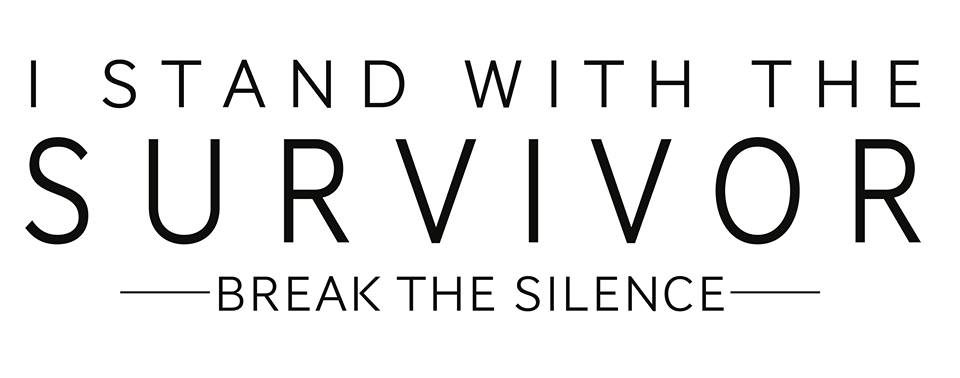
EA: Why do you think that there is so much silence around an issue as rampant and devastating as sexual violence?
SS: At the heart of it, I believe, is the failure of our criminal justice system to hold perpetrators accountable. Most Americans have a deep trust in our legal system where people are innocent until proven guilty. This system works most of the time, but in the cases of sexual violence, it fails. Most people don’t know of this failure, so when a person is not charged or not found guilty of sexual violence, the majority of people believe the system is just doing its job and that the accused person didn’t commit the crime. This paints victims, mostly women, as liars or mentally unstable – both of which invalidate the truth. We see that injustice, invalidation, blame, and shame effectively silence most survivors.
EA: How has your perception of sexual violence changed since your attack and starting the Break the Silence movement?
SS: No one ever talked to me about experiencing sexual violence before I was raped. It wasn’t an issue I thought much about, and in the rare instances I did, it felt far away…never something that would happen to me. Now that I’ve been raped and told my story, I hear a different survivor’s story every day. I recognize not only how many survivors there are, but that perpetrators are most often normal, everyday people that we love and trust.
EA: What words do you have for survivors of sexual violence who may be reading this and have not broken the silence?
SS: I’ll share the best advice I got on my healing journey: Do whatever you need to heal. Maybe that means breaking the silence and maybe that means never breaking the silence. There is no right way to heal, and breaking the silence is not the end of the healing journey, nor will it take all the pain away. It’s just a choice. Your healing is first and foremost, and I support you in doing whatever it takes for you to heal.
EA: What is the value of sexual violence crisis and resource centers, such as the Aurora Center, to survivors?
SS: Places like the Aurora Center do many things. Their presence validates that sexual violence happens in our community. They become safe places for survivors to be believed and get help. Additionally, they provide opportunities for survivors to do advocacy work and possibly use their traumatic experience(s) to do more good in the world.
EA: Why do you think a resource as critical and frequently utilized as the Aurora Center is underfunded on a 3.8 billion dollar campus?
SS: I think the Aurora Center speaks a truth almost no one wants to hear: sexual violence is pervasive on campus, and there are people on campus who are perpetrators. To fully support the Aurora Center and fund them would be to recognize a dark truth few have shown the courage to face. Nevertheless, we must find the courage to face this issue, and we must give the people who are leading this work the resources they need to do so effectively.

EA: How can those who do not have the ability to donate to the Aurora Center help support survivors on campus?
SS: Believe survivors. Offer choices. Practice feminism. Learn about psychological trauma. Consider how your seemingly everyday interactions with people have the power to be hurtful or healing in the aftermath of sexual violence. Use the power you have in these interactions to be a source of validation, compassion, and trauma-informed support.
EA: What needs to be said?
SS: We can’t leave healing up to rape crisis centers. Survivors need support from their family and friends. And because survivors surround each of us, we should all be trauma-informed.
To donate money and help bring the Aurora Center out of deficit visit z.umn.edu/fundaurora
To donate to Break the Silence and help fund future truth telling events visit breakthesilence.org
Sarah Super is a rape survivor, educator, and activist. She is the founder of Break the Silence - an organization striving to end rape culture, hold perpetrators accountable, and support survivors of sexual violence in healing. Previously, Sarah worked for Hennepin County as a training consultant and for the YWCA of Minneapolis' racial justice and public policy initiatives. Sarah earned a B.A. in American Studies and Sociology and a M.Ed. in Human Resource Development from the University of Minnesota.
Elise Armani is a fourth year BFA candidate, with a dual degree in Gender, Women and Sexuality studies and a minor in Art History. Elise is an artist and an independent curator, and works as the Projects & Programs assistant at WAM. In the off moments when she isn’t working, Elise enjoys reading, frolicking in nature, and spending time with her pitbull (child) Lando.
